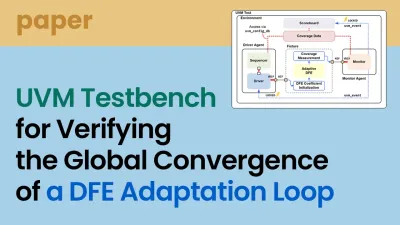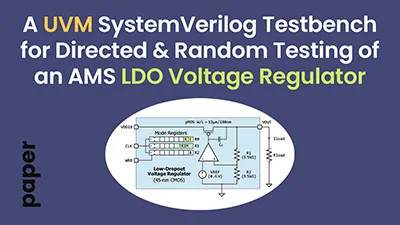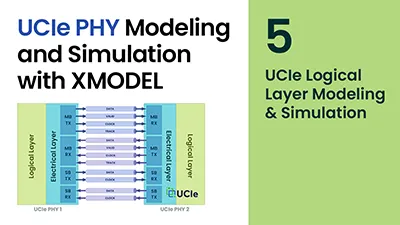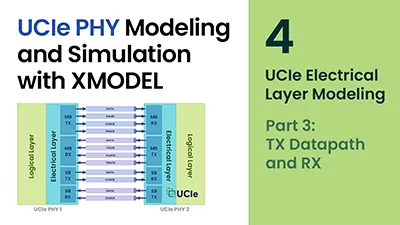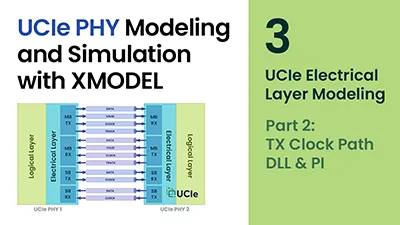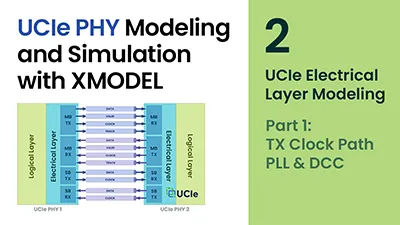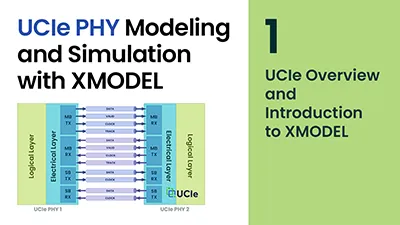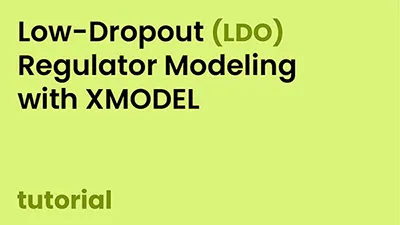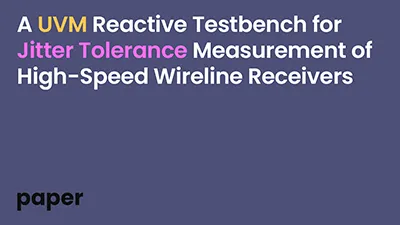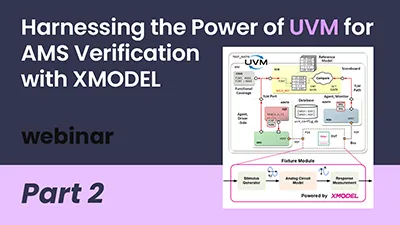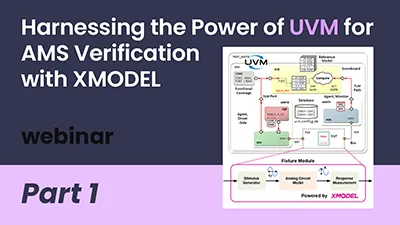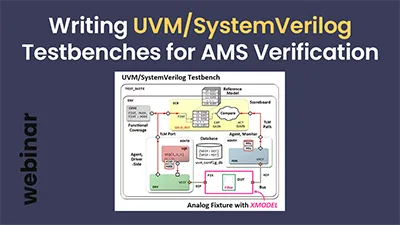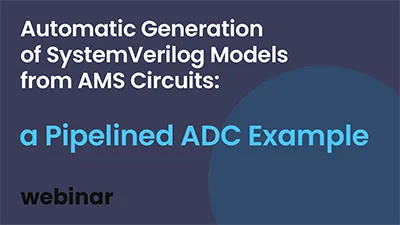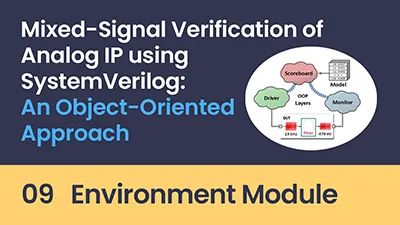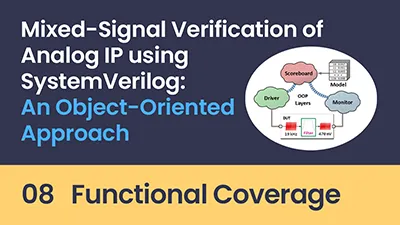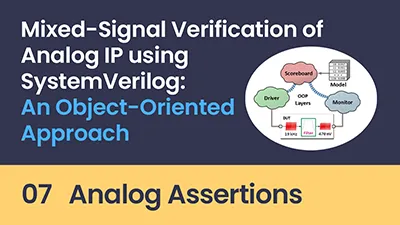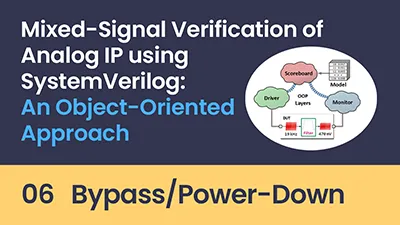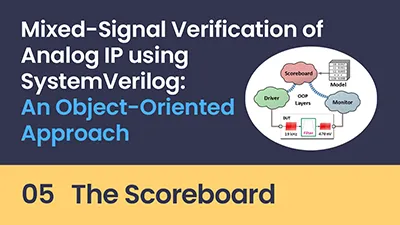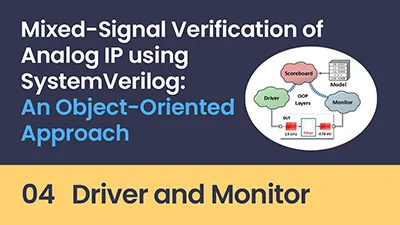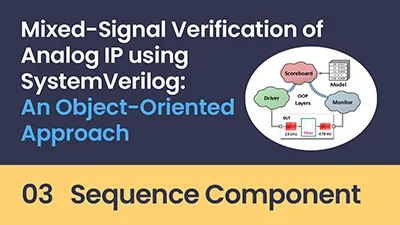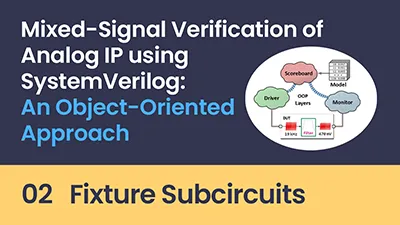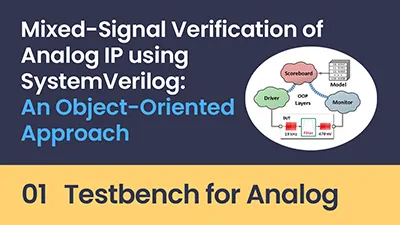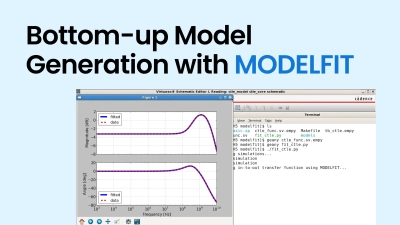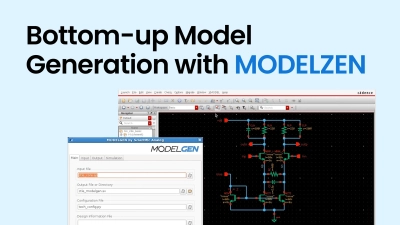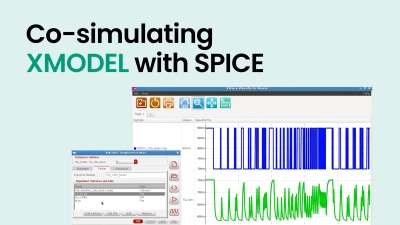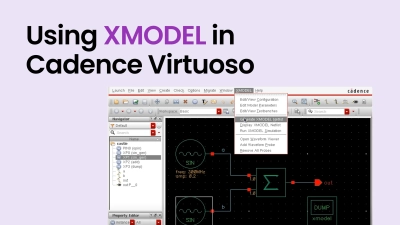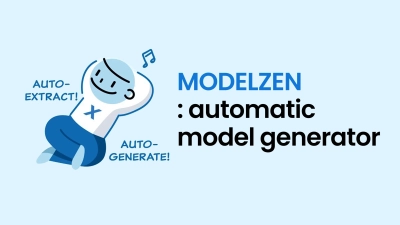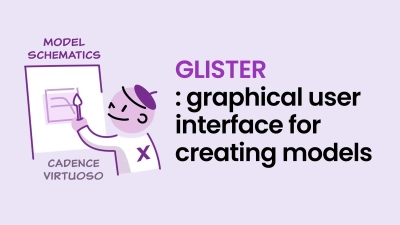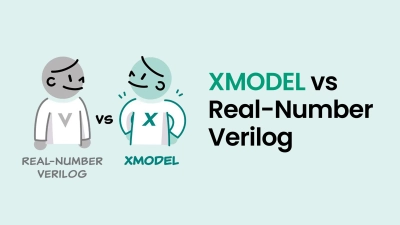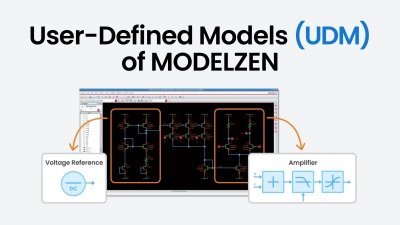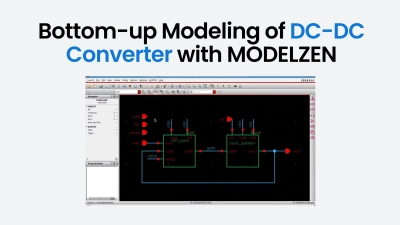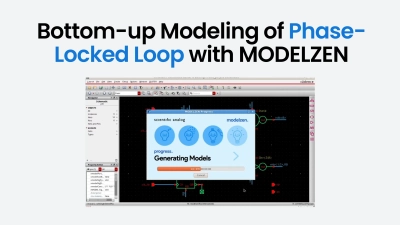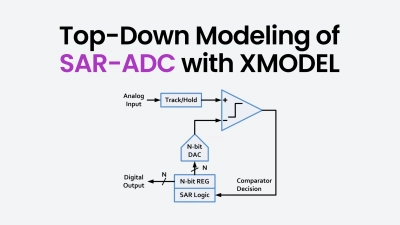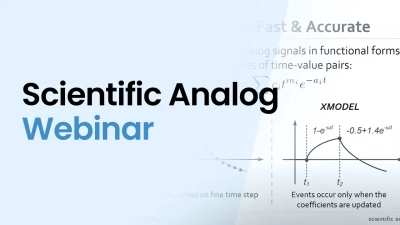Webinars
UVM Testbench for Verifying the Global Convergence of a DFE Adaptation Loop
35min
Jaeha Kim, “A UVM Testbench for Checking the Global Convergence of Analog/Mixed-Signal Systems: An Adaptive Decision-Feedback Equalizer Example”, Design and Verification Conference and Exhibition (DVCon) Europe, 2024.
Category: Webinars
Webinars
A UVM SystemVerilog Testbench for Directed & Random Testing of an AMS LDO Voltage Regulator
11min
Charles Dancak, “A UVM SystemVerilog Testbench for Directed & Random Testing of an AMS LDO Voltage Regulator”, Design and Verification Conference and Exhibition (DVCon) US, 2024.
Category: Webinars
Webinars
[5/5] UCIe PHY Modeling and Simulation with XMODEL
44min
This webinar presents the SystemVerilog models of a Universal Chiplet Interconnect Express (UCIe) interface, including both the analog circuits in the electrical layer and digital FSMs in the logical layer. The whole physical layer (PHY) model can be efficiently simulated in SystemVerilog, using Scientific Analog’s XMODEL.
Section 5: UCIe Logical Layer Modeling & Simulation
Category: Webinars
Webinars
[4/5] UCIe PHY Modeling and Simulation with XMODEL
35min
This webinar presents the SystemVerilog models of a Universal Chiplet Interconnect Express (UCIe) interface, including both the analog circuits in the electrical layer and digital FSMs in the logical layer. The whole physical layer (PHY) model can be efficiently simulated in SystemVerilog, using Scientific Analog’s XMODEL.
Section 4: UCIe Electrical Layer Modeling (Part 3: TX Datapath and RX)
Category: Webinars
Webinars
[3/5] UCIe PHY Modeling and Simulation with XMODEL
19min
This webinar presents the SystemVerilog models of a Universal Chiplet Interconnect Express (UCIe) interface, including both the analog circuits in the electrical layer and digital FSMs in the logical layer. The whole physical layer (PHY) model can be efficiently simulated in SystemVerilog, using Scientific Analog’s XMODEL.
Section 3: UCIe Electrical Layer Modeling (Part 2: TX Clock Path DLL & PI)
Category: Webinars
Webinars
[2/5] UCIe PHY Modeling and Simulation with XMODEL
29min
This webinar presents the SystemVerilog models of a Universal Chiplet Interconnect Express (UCIe) interface, including both the analog circuits in the electrical layer and digital FSMs in the logical layer. The whole physical layer (PHY) model can be efficiently simulated in SystemVerilog, using Scientific Analog’s XMODEL.
Section 2: UCIe Electrical Layer Modeling (Part 1: TX Clock Path PLL & DCC)
Category: Webinars
Webinars
[1/5] UCIe PHY Modeling and Simulation with XMODEL
25min
This webinar presents the SystemVerilog models of a Universal Chiplet Interconnect Express (UCIe) interface, including both the analog circuits in the electrical layer and digital FSMs in the logical layer. The whole physical layer (PHY) model can be efficiently simulated in SystemVerilog, using Scientific Analog’s XMODEL.
Section 1: UCIe Overview and Introduction to XMODEL
Category: Webinars
Tutorial
Low-Dropout (LDO) Regulator Modeling with XMODEL
16min
This video demonstrates how you can easily and effectively model the transient, DC, and AC characteristics of low-dropout regulators using XMODEL. This tutorial corresponds to the application note, ‘Low-Dropout Regulator Modeling with XMODEL’ located in the ‘Application Notes’ section of the Scientific Analog website.
Category: Tutorial
Webinars
[2/2] Harnessing the Power of UVM for AMS Verification with XMODEL
52min
This tutorial offers hands-on learning for writing UVM testbenches for analog/mixed-signal circuits. It will show that the framework of UVM can be extended to verifying analog circuits simply by using a well-defined fixture module encapsulating the device-under-verification (DUV) model and its AMS instrumentations described with XMODEL primitives.
Part 2
Category: Webinars
Webinars
[1/2] Harnessing the Power of UVM for AMS Verification with XMODEL
1h 40min
This tutorial offers hands-on learning for writing UVM testbenches for analog/mixed-signal circuits. It will show that the framework of UVM can be extended to verifying analog circuits simply by using a well-defined fixture module encapsulating the device-under-verification (DUV) model and its AMS instrumentations described with XMODEL primitives.
Part 1
Category: Webinars
Webinars
Writing UVM/SystemVerilog Testbenches for Analog/Mixed-Signal Verification
1h 37min
This webinar focuses on how to write UVM testbenches for analog/mixed-signal circuits. UVM (Universal Verification Methodology) is a framework of standardized SystemVerilog classes to build reusable and scalable testbenches for digital designs, and it can be extended to verifying analog circuits simply by using a fixture module that generates analog stimuli and measures analog responses with Scientific Analog’s XMODEL.
Category: Webinars
Webinars
Automatic Generation of SystemVerilog Models from Analog/Mixed-Signal Circuits: a Pipelined ADC Example
1h 15mins
The webinar addresses how to extract SystemVerilog models automatically from analog/mixed-signal circuits, and perform efficient verification of mixed-signal SoC’s using digital flows, such as UVM. It will introduce two modeling approaches, structural and functional, and demonstrate how these approaches work together using a pipelined analog-to-digital converter example.
Category: Webinars
Webinars
[9-10/10] Writing OOP-style SystemVerilog Testbench for Analog IPs
15min
This webinar addresses how to write an OOP-style SystemVerilog testbench for analog/mixed-signal circuits. The key testbench components such as the test sequence, driver, monitor, and scoreboard are presented in a step-by-step manner. Using a digitally-programmable analog filter as an example, this webinar discusses ways of reaching 100% functional coverage over the digital modes as well as analog inputs with random/directed tests and analog assertion checks.
Section 09: Environment Module
Section 10: OOP/XMODEL Guidelines
Category: Webinars
Webinars
[8/10] Writing OOP-style SystemVerilog Testbench for Analog IPs
10min
This webinar addresses how to write an OOP-style SystemVerilog testbench for analog/mixed-signal circuits. The key testbench components such as the test sequence, driver, monitor, and scoreboard are presented in a step-by-step manner. Using a digitally-programmable analog filter as an example, this webinar discusses ways of reaching 100% functional coverage over the digital modes as well as analog inputs with random/directed tests and analog assertion checks.
Section 08: Functional Coverage
Category: Webinars
Webinars
[7/10] Writing OOP-style SystemVerilog Testbench for Analog IPs
10min
This webinar addresses how to write an OOP-style SystemVerilog testbench for analog/mixed-signal circuits. The key testbench components such as the test sequence, driver, monitor, and scoreboard are presented in a step-by-step manner. Using a digitally-programmable analog filter as an example, this webinar discusses ways of reaching 100% functional coverage over the digital modes as well as analog inputs with random/directed tests and analog assertion checks.
Section 07: Analog Assertions
Category: Webinars
Webinars
[6/10] Writing OOP-style SystemVerilog Testbench for Analog IPs
6min
This webinar addresses how to write an OOP-style SystemVerilog testbench for analog/mixed-signal circuits. The key testbench components such as the test sequence, driver, monitor, and scoreboard are presented in a step-by-step manner. Using a digitally-programmable analog filter as an example, this webinar discusses ways of reaching 100% functional coverage over the digital modes as well as analog inputs with random/directed tests and analog assertion checks.
Section 06: Bypass/Power-Down
Category: Webinars
Webinars
[5/10] Writing OOP-style SystemVerilog Testbench for Analog IPs
8min
This webinar addresses how to write an OOP-style SystemVerilog testbench for analog/mixed-signal circuits. The key testbench components such as the test sequence, driver, monitor, and scoreboard are presented in a step-by-step manner. Using a digitally-programmable analog filter as an example, this webinar discusses ways of reaching 100% functional coverage over the digital modes as well as analog inputs with random/directed tests and analog assertion checks.
Section 05: The Scoreboard
Category: Webinars
Webinars
[4/10] Writing OOP-style SystemVerilog Testbench for Analog IPs
8min
This webinar addresses how to write an OOP-style SystemVerilog testbench for analog/mixed-signal circuits. The key testbench components such as the test sequence, driver, monitor, and scoreboard are presented in a step-by-step manner. Using a digitally-programmable analog filter as an example, this webinar discusses ways of reaching 100% functional coverage over the digital modes as well as analog inputs with random/directed tests and analog assertion checks.
Section 04: Driver and Monitor
Category: Webinars
Webinars
[3/10] Writing OOP-style SystemVerilog Testbench for Analog IPs
7min
This webinar addresses how to write an OOP-style SystemVerilog testbench for analog/mixed-signal circuits. The key testbench components such as the test sequence, driver, monitor, and scoreboard are presented in a step-by-step manner. Using a digitally-programmable analog filter as an example, this webinar discusses ways of reaching 100% functional coverage over the digital modes as well as analog inputs with random/directed tests and analog assertion checks.
Section 03: Sequence Component
Category: Webinars
Webinars
[2/10] Writing OOP-style SystemVerilog Testbench for Analog IPs
12min
This webinar addresses how to write an OOP-style SystemVerilog testbench for analog/mixed-signal circuits. The key testbench components such as the test sequence, driver, monitor, and scoreboard are presented in a step-by-step manner. Using a digitally-programmable analog filter as an example, this webinar discusses ways of reaching 100% functional coverage over the digital modes as well as analog inputs with random/directed tests and analog assertion checks.
Section 02: Fixture Subcircuits
Category: Webinars
Webinars
[1/10] Writing OOP-style SystemVerilog Testbench for Analog IPs
16min
This webinar addresses how to write an OOP-style SystemVerilog testbench for analog/mixed-signal circuits. The key testbench components such as the test sequence, driver, monitor, and scoreboard are presented in a step-by-step manner. Using a digitally-programmable analog filter as an example, this webinar discusses ways of reaching 100% functional coverage over the digital modes as well as analog inputs with random/directed tests and analog assertion checks.
Section 01: Testbench for Analog
Category: Webinars
Tutorial
Bottom-up Model Generation with MODELFIT
6min
This video demonstrates MODELFIT, a python library for fitting SPICE simulation data to XMODEL primitives. By leveraging the design expertise, the functional models produced by MODELFIT often provide faster speeds and higher accuracies.
Category: Tutorial
Tutorial
Bottom-up Model Generation with MODELZEN
8min
This video showcases how MODELZEN converts any SPICE netlist into an XMODEL netlist in SystemVerilog, using a continuous-time linear equalizer (CTLE) example. The extracted models run efficiently in SystemVerilog thanks to the event-driven simulation algorithm of XMODEL.
Category: Tutorial
Tutorial
Co-simulating XMODEL with SPICE
8min
This video demonstrates how to run a co-simulation between XMODEL and SPICE using a continuous-time linear equalizer (CTLE) example. GLISTER automatically prepares the co-simulation netlists and control files based on the hierarchy configuration and XMODEL works seamlessly with the host SystemVerilog simulator and SPICE simulator.
Category: Tutorial
Demo
GLISTER: graphical user interface for creating models
8min
This video gives introduction to GLISTER, a graphical user interface for creating analog circuit models. GLISTER lets you compose top-down models of your circuits in schematic forms by putting together the XMODEL primitive symbols.
Category: Demo
Demo
XMODEL vs Real-Number Verilog
15min
How is XMODEL different from Real-Number Verilog, which is another way of modeling analog circuits in SystemVerilog? This video highlights the key competitive advantages of XMODEL, which can run fast, event-driven simulation of analog circuits without sacrificing accuracy.
Category: Demo
Introduction
Modeling Silicon Photonic Systems with XMODEL
7min
Silicon photonic systems are fast emerging but also posing challenges to verification, as they integrate all the photonics, analog, and digital components in a single chip. Check out how the XMODEL’s event-driven simulation algorithm can be extended to handle such an impossible task.
Category: Introduction
Demo
Bottom-up Modeling of DC-DC Converter with MODELZEN
12min
This video demonstrates how one can automatically extract bottom-up models from a DC-DC regulator circuit using MODELZEN. With the extracted models, one can perform efficient verification of the circuits all in SystemVerilog.
Category: Demo
Demo
Bottom-up Modeling of Phase-Locked Loop with MODELZEN
12min
This video demonstrates how one can extract bottom-up models from a phase-locked loop circuit using MODELZEN. MODELZEN can extract either circuit-level models or functional models via the User-Defined Model (UDM) interface.
Category: Demo
Demo
Top-Down Modeling of SAR-ADC with XMODEL
8min
A successive approximation register (SAR) ADC consists of an analog front-end and a digital finite-state machine and digitizes the analog input using a binary search algorithm. This video shows the top-down modeling of a SAR-ADC in XMODEL using GLISTER.
Category: Demo
Introduction
Scientific Analog Webinar
37min
XMODEL offers the best way to verify analog circuits in SystemVerilog. XMODEL is a plug-in extension to a SystemVerilog simulator enabling fast and accurate analog/mixed-signal simulation with functional- and circuit-level models. GLISTER and MODELZEN are top-down and bottom-up modeling tools that make analog modeling a breeze.
Category: Introduction



